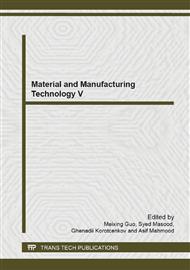[1]
Ribatski G., Jacobi A.M., Falling-film evaporation on horizontal tubes - a critical review, International Journal of Refrigeration, 28 (2005) p.635–653.
DOI: 10.1016/j.ijrefrig.2004.12.002
Google Scholar
[2]
Patel VK, Rao RV., Design optimization of shell-and-tube heat exchanger using particle swarm optimization technique. Applied Thermal Engineering, 30 (2010) p.1417–25.
DOI: 10.1016/j.applthermaleng.2010.03.001
Google Scholar
[3]
Ravagnani M., Caballero J.A. A MINLP model for the rigorous design of shell and tube heat exchangers using the TEMA standards. Chemical Engineering Research and Design, 85 (2007) p.1–13.
DOI: 10.1016/s0263-8762(07)73182-9
Google Scholar
[4]
Rajasekaran S., Kannadasan T. Optimization of shell and tube heat exchangers using modified genetic algorithm. International Journal of Control and Automation, 3 (2010) p.1–10.
Google Scholar
[5]
Allen B, Savard-Goguen M, Gosselin L. Optimizing heat exchanger networks with genetic algorithms for designing each heat exchanger including condensers. Applied Thermal Engineering, 29 (2009) p.3437–3481.
DOI: 10.1016/j.applthermaleng.2009.06.006
Google Scholar
[6]
Ponce-Ortega J.M., Serna-González M., Jiménez-Gutiérrez A. Use of genetic algorithms for the optimal design of shell-and-tube heat exchangers. Applied Thermal Engineering, 29 (2009) p.203–212.
DOI: 10.1016/j.applthermaleng.2007.06.040
Google Scholar
[7]
Guo J, Cheng L, Xu M. Optimization design of shell-and-tube heat exchanger by entropy generation minimization and genetic algorithm. Applied Thermal Engineering, 29 (2009) p.2954–60.
DOI: 10.1016/j.applthermaleng.2009.03.011
Google Scholar
[8]
Mizutani F.T., Pessoa F.L.P., Queiroz E.M., Hauan S., Grossmann I.E. Mathematical programming model for heat-exchanger network synthesis including detailed heat-exchanger designs. 1. Shell-and-tube heat-exchanger design. Industrial & Engineering Chemistry Research, 42 (2003).
DOI: 10.1021/ie020964u
Google Scholar
[9]
Ponce-Ortega JM, Serna-González M, Salcedo-Estrada LI, Jiménez-Gutiérrez A. Minimum-investment design of multiple shell and tube heat exchangers using a MINLP formulation. Chemical Engineering Research and Design, 84 (2006) p.905–10.
DOI: 10.1205/cherd05029
Google Scholar
[10]
Pogiatzis TA, Wilson DI, Vassiliadis VS. Scheduling the cleaning actions for a fouled heat exchanger subject to ageing: MINLP formulation. Computers & Chemical Engineering, 39 (2012) p.179–85.
DOI: 10.1016/j.compchemeng.2011.12.012
Google Scholar
[11]
Soltan BK, Salffar-Avval M, Damangir E. Minimizing capital and operating costs of shell and tube condensers using optimum baffle spacing. Applied Thermal Engineering, 24 (2004) p.2801–10.
DOI: 10.1016/j.applthermaleng.2004.04.005
Google Scholar
[12]
Fesanghary M, Damangir E, Soleimani I. Design optimization of shell and tube heat exchangers using global sensitivity analysis and harmony search algorithm. Applied Thermal Engineering, 29 (2009) p.1026–1057.
DOI: 10.1016/j.applthermaleng.2008.05.018
Google Scholar
[13]
Chayma T., Mori Y.H., Optical method for measuring uniform thickness of the order of 10 mm- 1mm of transparent solid and liquid films, Review of Scientific Instruments, 58 (1987) pp.1860-1864.
DOI: 10.1063/1.1139533
Google Scholar
[14]
Thorncroft G.E., Klausner J.F., A capacitance sensor for two-phase liquid film thickness measurements in a square duct, Journal of Heat Transfer, Transaction ASME, 119 (1997) pp.164-169.
DOI: 10.1115/1.2819103
Google Scholar
[15]
Zhang J.T., Peng X.F., Peterson G.P., Experimental investigation on the hydrodynamics of falling liquid film flow by nonlinear description procedure, International Journal of Heat and Mass Transfer, 43 (2000) pp.3847-3852.
DOI: 10.1016/s0017-9310(99)00371-3
Google Scholar
[16]
Wang X.F., He M.G., Zhang Y., Numerical simulation of the liquid flowing outside the Tube of the Horizontal-tube Falling Film Evaporator, J. Eng. Thermophysics, 29 (2008) pp.1347-1350.
DOI: 10.4028/www.scientific.net/amr.614-615.296
Google Scholar
[17]
Louahlia-Gualous H., Baonga J. B., Panday P.K., Régimes d'écoulement et mesure de l'épaisseur d'un film liquide ruisselant autour d'un tube horizontal, The Canadian Journal of Chemical Engineering, 81, 6 (2003) p.1222–1231.
DOI: 10.1002/cjce.5450810611
Google Scholar
[18]
Coney M.W.E., The theory and application of conductance probes for the measurement of liquid film thickness in two-phase flow. Journal of Physics Education. 6 (1973) pp.903-910.
DOI: 10.1088/0022-3735/6/9/030
Google Scholar
[19]
Brown R. C, the use of wire probes for measurement of liquid film thickness in annular gas-liquid flows, Can. J. Chem. Eng, 56 (1978) pp.754-757.
DOI: 10.1002/cjce.5450560618
Google Scholar
[20]
Rogers J.T., Goindi S.S., Experimental laminar falling film heat transfer coefficients on large diameter horizontal tube, Canadian Journal of Chemical Engineering, 67 (1989) pp.560-568.
DOI: 10.1002/cjce.5450670406
Google Scholar
[21]
Dukler A.E., Characteristics of flow in falling liquid films, Chemical Engineering. Progress, 48, 11, (1952) pp.557-563.
Google Scholar
[22]
Fujita Y., Tustsui M., Evaporation heat transfer of falling film on horizontal tube, Part I, analytical study, Experimental Thermal and Fluid Science, 24, 1 (1995) pp.3469-3475.
Google Scholar
[23]
Hu X., Jacobi A.M., Departure-site spacing for liquid droplets and jets falling between horizontal circular tubes, Experimental Thermal and Fluid Science, 16 (1998) pp.322-331.
DOI: 10.1016/s0894-1777(97)10031-0
Google Scholar
[24]
Yung B., Lorentz J.J., Ganic E.N., Vapor/liquid interaction and entrainment in falling film evaporation, Journal of Heat Transfer, Transaction ASME, 102 (1980) pp.20-25.
DOI: 10.1115/1.3244242
Google Scholar
[25]
Mitrovic J., Influence of tube spacing and flow rate on heat transfer from a horizontal tube to a falling liquid film, Proc. 8th International Heat Transfer Conference, San Francisco, 4 (1986) p.1949-(1956).
DOI: 10.1615/ihtc8.1700
Google Scholar
[26]
Rogers J.T., Laminar falling film flow and heat transfer characteristics on horizontal tubes, Canadian Journal of Chemical Engineering, (1986) pp.213-222.
DOI: 10.1002/cjce.5450590212
Google Scholar
[27]
Chyu M.C., Bergles A.E., An analytical and experimental study of falling film evaporation on horizontal tube, J. Heat Transfer, Transaction of the ASME 109 (1987) pp.983-990.
DOI: 10.1115/1.3248214
Google Scholar


